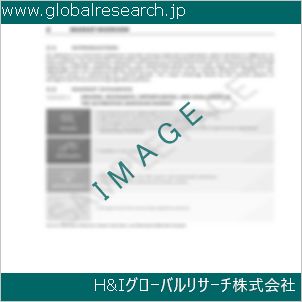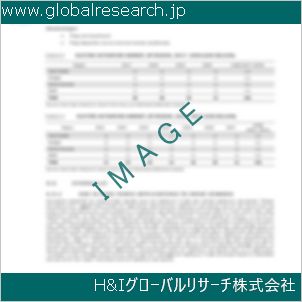Table of Contents
1 Industry Overview of Zinciodate
1.1 Definition and Specifications of Zinciodate
1.1.1 Definition of Zinciodate
1.1.2 Specifications of Zinciodate
1.2 Classification of Zinciodate
1.3 Applications of Zinciodate
1.3.1 Nuclear Application
1.3.2 Non-Nuclear Application
1.4 Industry Chain Structure of Zinciodate
1.5 Industry Overview and Major Regions Status of Zinciodate
1.5.1 Industry Overview of Zinciodate
1.5.2 Global Major Regions Status of Zinciodate
1.6 Industry Policy Analysis of Zinciodate
1.7 Industry News Analysis of Zinciodate
2 Manufacturing Cost Structure Analysis of Zinciodate
2.1 Raw Material Suppliers and Price Analysis of Zinciodate
2.2 Equipment Suppliers and Price Analysis of Zinciodate
2.3 Labor Cost Analysis of Zinciodate
2.4 Other Costs Analysis of Zinciodate
2.5 Manufacturing Cost Structure Analysis of Zinciodate
2.6 Manufacturing Process Analysis of Zinciodate
3 Technical Data and Manufacturing Plants Analysis of Zinciodate
3.1 Capacity and Commercial Production Date of Global Zinciodate Major Manufacturers in 2023
3.2 Manufacturing Plants Distribution of Global Zinciodate Major Manufacturers in 2023
3.3 R&D Status and Technology Source of Global Zinciodate Major Manufacturers in 2023
3.4 Raw Materials Sources Analysis of Global Zinciodate Major Manufacturers in 2023
4 Capacity, Production and Revenue Analysis of Zinciodate by Regions, Types and Manufacturers
4.1 Global Capacity, Production and Revenue of Zinciodate by Regions 2019-2024
4.2 Global and Major Regions Capacity, Production, Revenue and Growth Rate of Zinciodate 2019-2024
4.3 Global Capacity, Production and Revenue of Zinciodate by Types 2019-2024
4.4 Global Capacity, Production and Revenue of Zinciodate by Manufacturers 2019-2024
5 Price, Cost, Gross and Gross Margin Analysis of Zinciodate by Regions, Types and Manufacturers
5.1 Price, Cost, Gross and Gross Margin Analysis of Zinciodate by Regions 2019-2024
5.2 Price, Cost, Gross and Gross Margin Analysis of Zinciodate by Types 2019-2024
5.3 Price, Cost, Gross and Gross Margin Analysis of Zinciodate by Manufacturers 2019-2024
6 Consumption Volume, Consumption Value and Sale Price Analysis of Zinciodate by Regions, Types and Applications
6.1 Global Consumption Volume and Consumption Value of Zinciodate by Regions 2019-2024
6.2 Global and Major Regions Consumption Volume, Consumption Value and Growth Rate of Zinciodate 2019-2024
6.3 Global Consumption Volume and Consumption Value of Zinciodate by Types 2019-2024
6.4 Global Consumption Volume and Consumption Value of Zinciodate by Applications 2019-2024
6.5 Sale Price of Zinciodate by Regions 2019-2024
6.6 Sale Price of Zinciodate by Types 2019-2024
6.7 Sale Price of Zinciodate by Applications 2019-2024
6.8 Market Share Analysis of Zinciodate by Different Sale Price Levels
7 Supply, Import, Export and Consumption Analysis of Zinciodate
7.1 Supply, Consumption and Gap of Zinciodate 2019-2024
7.2 Global Capacity, Production, Price, Cost, Revenue, Supply, Import, Export and Consumption of Zinciodate 2019-2024
7.3 USA Capacity, Production, Price, Cost, Revenue, Supply, Import, Export and Consumption of Zinciodate 2019-2024
7.4 EU Capacity, Production, Price, Cost, Revenue, Supply, Import, Export and Consumption of Zinciodate 2019-2024
7.5 China Capacity, Production, Price, Cost, Revenue, Supply, Import, Export and Consumption of Zinciodate 2019-2024
7.6 Japan Capacity, Production, Price, Cost, Revenue, Supply, Import, Export and Consumption of Zinciodate 2019-2024
8 Major Manufacturers Analysis of Zinciodate
8.1 Manufacturer One
8.1.1 Company Profile
8.1.2 Product Picture and Specifications
8.1.2.1 Type I
8.1.2.2 Type II
8.1.2.3 Type III
8.1.3 Capacity, Production, Price, Cost, Gross and Revenue
8.1.4 Contact Information
8.2 Manufacturer Two
8.2.1 Company Profile
8.2.2 Product Picture and Specifications
8.2.2.1 Type I
8.2.2.2 Type II
8.2.2.3 Type III
8.2.3 Capacity, Production, Price, Cost, Gross and Revenue
8.2.4 Contact Information
8.3 Manufacturer Three
8.3.1 Company Profile
8.3.2 Product Picture and Specifications
8.3.2.1 Type I
8.3.2.2 Type II
8.3.2.3 Type III
8.3.3 Capacity, Production, Price, Cost, Gross and Revenue
8.3.4 Contact Information
8.4 Manufacturer Four
8.4.1 Company Profile
8.4.2 Product Picture and Specifications
8.4.2.1 Type I
8.4.2.2 Type II
8.4.2.3 Type III
8.4.3 Capacity, Production, Price, Cost, Gross and Revenue
8.4.4 Contact Information
8.5 Manufacturer Five
8.5.1 Company Profile
8.5.2 Product Picture and Specifications
8.5.2.1 Type I
8.5.2.2 Type II
8.5.2.3 Type III
8.5.3 Capacity, Production, Price, Cost, Gross and Revenue
8.5.4 Contact Information
…
9 Marketing Trader or Distributor Analysis of Zinciodate
9.1 Marketing Channels Status of Zinciodate
9.2 Traders or Distributors with Contact Information of Zinciodate by Regions
9.3 Ex-work Price, Channel Price and End Buyer Price Analysis of Zinciodate
9.4 Regional Import, Export and Trade Analysis of Zinciodate
10 Industry Chain Analysis of Zinciodate
10.1 Upstream Major Raw Materials Suppliers Analysis of Zinciodate
10.1.1 Major Raw Materials Suppliers with Contact Information Analysis of Zinciodate
10.1.2 Major Raw Materials Suppliers with Supply Volume Analysis of Zinciodate by Regions
10.2 Upstream Major Equipment Suppliers Analysis of Zinciodate
10.2.1 Major Equipment Suppliers with Contact Information Analysis of Zinciodate
10.2.2 Major Equipment Suppliers with Product Pictures Analysis of Zinciodate by Regions
10.3 Downstream Major Consumers Analysis of Zinciodate
10.3.1 Major Consumers with Contact Information Analysis of Zinciodate
10.3.2 Major Consumers with Consumption Volume Analysis of Zinciodate by Regions
10.4 Supply Chain Relationship Analysis of Zinciodate
11 Development Trend of Analysis of Zinciodate
11.1 Capacity, Production and Revenue Forecast of Zinciodate by Regions and Types
11.1.1 Global Capacity, Production and Revenue of Zinciodate by Regions 2024-2029
11.1.2 Global and Major Regions Capacity, Production, Revenue and Growth Rate of Zinciodate 2024-2029
11.1.3 Global Capacity, Production and Revenue of Zinciodate by Types 2024-2029
11.2 Consumption Volume and Consumption Value Forecast of Zinciodate by Regions, Types and Applications
11.2.1 Global Consumption Volume and Consumption Value of Zinciodate by Regions 2024-2029
11.2.2 Global and Major Regions Consumption Volume, Consumption Value and Growth Rate of Zinciodate 2024-2029
11.2.3 Global Consumption Volume and Consumption Value of Zinciodate by Types 2024-2029
11.2.4 Global Consumption Volume and Consumption Value of Zinciodate by Applications 2024-2029
11.3 Supply, Import, Export and Consumption Forecast of Zinciodate
11.3.1 Supply, Consumption and Gap of Zinciodate 2024-2029
11.3.2 Global Capacity, Production, Price, Cost, Revenue, Supply, Import, Export and Consumption of Zinciodate 2024-2029
11.3.3 USA Capacity, Production, Price, Cost, Revenue, Supply, Import, Export and Consumption of Zinciodate 2024-2029
11.3.4 EU Capacity, Production, Price, Cost, Revenue, Supply, Import, Export and Consumption of Zinciodate 2024-2029
11.3.5 China Capacity, Production, Price, Cost, Revenue, Supply, Import, Export and Consumption of Zinciodate 2024-2029
11.3.6 Japan Capacity, Production, Price, Cost, Revenue, Supply, Import, Export and Consumption of Zinciodate 2024-2029
12 New Project Investment Feasibility Analysis of Zinciodate
12.1 New Project SWOT Analysis of Zinciodate
12.2 New Project Investment Feasibility Analysis of Zinciodate
13 Conclusion of the Global Zinciodate (CAS 7790-37-6) Industry 2024 Market Research Report
| ※参考情報 ヨウ素酸亜鉛(Zinciodate)は、化学式 Zn(IO₃)₂ を持つ無機化合物で、亜鉛の塩の一種です。この化合物は主に晒された環境条件に耐性を持つことから、さまざまな用途に利用されています。 ヨウ素酸亜鉛の化学的特性としては、結晶構造を持ち、水溶性があることが挙げられます。常温常圧では、白色または微黄色の粉末として存在し、光に対して比較的安定しています。また、弱酸性の環境での安定性が高く、通常の条件下では分解しにくい性質があります。そのため、特定の条件での使用が推奨されます。 この化合物は、特にその反応性や催化特性から注目されています。ヨウ素酸亜鉛は、さまざまな化学反応において、触媒としての役割を果たすことがあります。例えば、有機合成や無機合成のプロセスにおいて、反応速度を促進させたり、特定の生成物を選択的に得るために使用されることがあります。 ヨウ素酸亜鉛の用途は多岐にわたりますが、主に以下の領域で使用されています。一つは、農業や園芸分野における肥料としての利用です。亜鉛は植物の成長に必要な微量元素であり、ヨウ素酸亜鉛は亜鉛を効率的に供給するための肥料として広く使用されています。特に、亜鉛不足が懸念される土壌条件下では、植物の栄養補給を補助する重要な役割を果たします。 次に、医療分野における応用も注目されています。ヨウ素酸亜鉛は、抗菌剤や消毒剤としての性質を持っているため、外科手術や医療器具の殺菌処理に利用されることがあります。また、ヨウ素化合物は放射線治療の補助剤としても研究されています。特に、放射線治療の過程において、ヨウ素酸亜鉛を使用することで、周辺組織への影響を軽減する可能性があるため、今後の研究が期待されています。 さらに、工業的な用途においても重要です。ヨウ素酸亜鉛は、ガラスやセラミックの製造過程において、特定の性能向上を図る添加剤として使用されます。特に、耐熱性や耐腐食性を高めるための材料としての利用価値が高いとされており、これにより製品の寿命や品質向上に寄与しています。 ヨウ素酸亜鉛の製造は主に、亜鉛塩とヨウ素酸を反応させることによって行われます。この反応において、適切な条件が保たれることが重要で、この調整によって純度の高い製品を得ることができます。また、製造プロセスにおいては、異なるモル比や反応温度を調整することで、さまざまな特性を持つ製品が得られます。 最近の研究では、ヨウ素酸亜鉛を用いた新しい材料の開発や機能性向上に関する取り組みが進められており、ナノテクノロジーとの結合も注目されています。ナノスケールでの応用により、より高い性能や新たな特性を持つ材料の開発が期待されています。特に、エネルギー貯蔵や変換技術、環境浄化技術においても、重要な役割を果たす可能性が示唆されています。 また、環境への配慮も重要なテーマとなっています。ヨウ素酸亜鉛は、その安定性や生物分解性において、他の化合物と比べて環境に優しい選択肢となる可能性があります。環境に対する影響を最小限に抑えつつ、効果的な用途を実現するための研究も進められています。 最後に、ヨウ素酸亜鉛はその特性に基づき、さまざまな業界での応用が期待されていますが、その取り扱いや使用に際しては注意が必要です。特に、化学物質としての取り扱いに際しては、安全性や環境への影響を考慮し、適切な管理が求められます。今後の研究と技術の進展により、より安全で持続可能な利用が実現されることが期待されています。 このように、ヨウ素酸亜鉛は多岐にわたる用途を持つ化合物として、さまざまな分野での利用が進んでいます。その特性を理解し、適切に活用することで、これからの研究開発において新しい可能性を開くことができると言えるでしょう。 |
❖ 免責事項 ❖
http://www.globalresearch.jp/disclaimer












